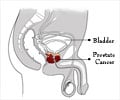Preliminary results show that a shortened course of radiation therapy for prostate cancer called stereotactic body radiation therapy (SBRT) provides good PSA response for early-stage
Preliminary results show that a shortened course of radiation therapy for prostate cancer called stereotactic body radiation therapy (SBRT) provides good PSA response for early-stage prostate cancer and has the same side effects as other treatments, according to a study. Study authors caution that further follow-up will be necessary to establish that SBRT is as effective in the long term as other proven treatments.
Radiation therapy is an effective way to treat localized prostate cancer. Proven successful treatments include brachytherapy (seed implants) where radiation sources are placed directly into the prostate and external beam radiation therapy where doctors give small daily doses of radiation to the prostate, five days a week, for eight weeks to give enough radiation to kill the cancer cells while sparing nearby healthy tissue.External beam radiation therapy can be a very effective and minimally invasive treatment. However, the length of treatment can be burdensome for some patients, particularly those who live very far from a treatment facility. Doctors have been investigating ways to shorten the course of the treatment through a technique called stereotactic body radiation therapy, where radiation oncologists give a higher dose of radiation every day for five days. Growing biologic evidence also suggests that delivering radiotherapy in this fashion might be more effective for prostate cancer than conventionally protracted courses.
In this study, researchers from Stanford University treated 41 men with low-risk prostate cancer with SBRT. After a median follow-up of 33 months, no man in the study has seen his cancer return. Men in the study reported side effects, including urinary and rectal problems that were no better or worse than with other prostate cancer radiation treatments.
"There is great enthusiasm in reducing the length of treatment for prostate cancer while also possibly improving its effectiveness, and these early results are very promising for men with early-stage prostate cancer," Christopher King, Ph.D., M.D., an associate professor of radiation oncology at Stanford University School of Medicine in Stanford, Calif., said.
"However, it can often take as long as 10 years to see late side effects and recurrences, so we will have to monitor these men closely and cautiously pursue these treatments further before we can confidently say that SBRT is as good as other proven prostate cancer treatments, like external beam radiation therapy, brachytherapy or surgery."
Source-Eurekalert
SRM






![Prostate Specific Antigen [PSA] Prostate Specific Antigen [PSA]](https://www.medindia.net/images/common/patientinfo/120_100/prostate-specific-antigen.jpg)








